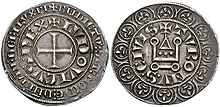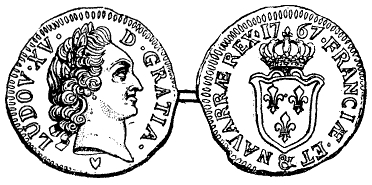French sol
The sol, later called a sou, is the name of a number of different coins, for accounting or payment, dating from Antiquity to today.
Doing honour to its name, the new currency earned the reputation of unalterability, crossing almost unchanged the decline and fall of the Western Roman Empire, and the great invasions and the creation of Germanic kingdoms throughout Europe.
Not only was it issued in the Byzantine Empire until the 11th century under the name of nomisma, but the solidus was imitated by the barbarian kings, particularly the Merovingians, albeit most often in the form of a "third of a sou" (tremissis).
With rare exceptions (such as Saint Louis' "gros"[clarification needed]), the denarius was for a long time in practice the only coin in circulation, with solidi and pounds used only as accounting units.
Only members of the money changers corporation could find their way among the equivalences and the many currencies used in Europe at each period, and therefore were unavoidable for most non-local commercial operations.
Used for over a thousand years, the word "sou" is deeply rooted in the French language and expressions.





